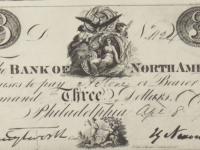With the announcement that our $10 bill will include a woman, it is the perfect opportunity to teach your students about the history of our currency and begin a conversation on the new look of the $10 bill. Coincidentally, this is not the first time a woman will be on United States currency.
In fact, our currency was not even standardized the way we see it today until the early 1900s. Before that each bank featured their own currency, often with more local significance. For example, the Bank of North America, started in Philadelphia, often displayed the image of William Penn on their paper currency, and even showcased a dog on its $500 bill, both shown below.
These images can also be used to talk about the style of the currency and how they featured multiple images rather than how we see currency today. It would be interesting to discuss with students why the different banks would choose these images to represent themselves. In the image below, you see Franklin and his wife are featured on a $5 bill from 1857. It seems like an odd combination as in addition, there is a train on the right hand side. This could be referring to the Industrial Revolution, but 1857 was also a time of financial panic. President Buchanan decided that the paper-money system, which by 1865 was 1/3 counterfeit, was the root of the cause, and he called for all bills under twenty dollars to be removed from circulation.
I understand that the "ten" is the next in line for a redesign, yet it is my humble opinion that it should be Andrew Jackson on the $20 dollar bill that is changed, not Alexander Hamilton on the $10 bill, who was essentially the founder of our entire financial system. In any case, it is high time we feature a notable woman with amazing contributions to this country. These images are a wonderful tool for students to understand the history of our economy and currencies, as well as, an opportunity to further women’s studies as students look for the perfect candidate.
If you would like PDF versions of this currency for your classroom, please contact us. These images, and more, will also be featured in our upcoming Unit Plan on teaching financial literacy using the Bank of North America records and our upcoming teacher workshop on Investigating our Economic History.

